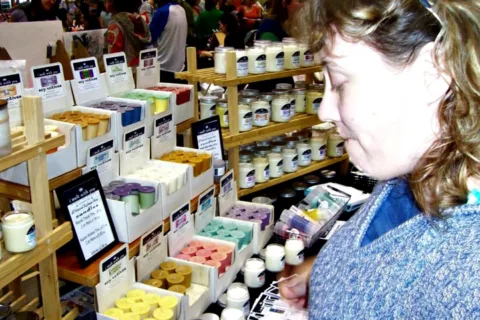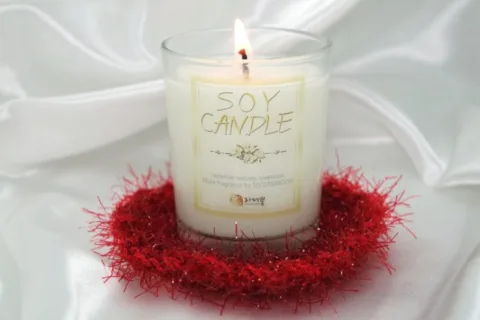For me, it’s very easy to see why using soy wax candles and other soy products makes sense.
However, maybe you simply haven’t had the opportunity to try soy candles yet.
I thought I’d share some of the reasons that so many people prefer soy candles over regular candles which are made from paraffin…
Why Soy Candles Are So Great
#1 – Soy candles are natural since they’re made from vegetable oil (soybeans). On the other hand, paraffin candles are made from petroleum oil. As a result, soy wax candles do not increase the CO2 level in the atmosphere like paraffin candles do. Furthermore, soy candles do not require chemicals to scent them.
For the record… if a soy candle is made from 100% soy (not all are; some are blended with beeswax or other waxes), and scented with essentials oils instead of chemical fragrances (as many are), then it can be called an all-natural soy candle.
Soy wax is a vegetable wax made from the oil of soybeans. After harvesting, the beans are cleaned, cracked, de-hulled, and rolled into flakes. The oil is then extracted from the flakes and hydrogenated. Source
#2 – Soy candles burn 50% longer than regular candles. Therefore, even though soy wax candles are sometimes more expensive than paraffin wax candles to buy, they are still more cost-effective in the long run. For comparison’s sake, soy candles generally cost less than beeswax candles (another natural wax alternative to paraffin). Furthermore, soy candles burn evenly, leaving almost no excess wax on the sides of the jar.
Soy not only burns cleaner, but slower too. A soy candle can burn up to twice as long (sometimes even more!) than paraffin, giving you twice the candle. Source
#3 – Soy candles burn cleaner than regular paraffin candles do. As a result, they don’t produce much black soot like paraffin candles do. Candle soot is more of a nuisance than you might realize. If you burn a lot of candles, over time it can discolor your walls & furniture and stain the edges of your carpet!
If you have ever had a soy wax candle in the past that did leave black soot around the jar, there are several reasons this may have happened. One explanation is it wasn’t 100% soy, but rather a soy/paraffin blend. Many advertise “soy candle” have unknown blends that you may not catch unless you search deep into their site. If it doesn’t say 100% or tell you what’s in the candles, watch out. Another reason you see black soot could have been the use of metal wicks. While no candle made in the US has lead, they can have zinc. Zinc wicks are not toxic like lead, but they will produce more soot than cotton or hemp wicks. Source
#4 – Soy candles are non-toxic since they are made of vegetable oil, have a lower melting point (so the wax itself doesn’t get as hot), produce negligible amounts of soot, and release no known carcinogens into the air. Compared to paraffin candles, soy wax candles are much healthier for humans, pets, and the environment. Plus, they clean up easier (just use soap and water) when the wax is spilled onto candle holders, carpet, and furniture pieces.
Paraffin candles release a petro-carbon soot that stains your walls, furniture and is circulated through your air ducts. This soot, according to the American Lung Association, contains 11 documented toxins, 2 of which are known carcinogens — toluene and benzene. Source
#5 – The scent from soy candles is much stronger and more pleasant than the scent from paraffin wax candles. Because of the lower melting point of soy wax, there is a larger amount of the liquid wax pool around the candle wick itself. It is from this liquid wax pool and the wick itself that the essential oils evaporate into the atmosphere.
When it’s said that a candle scent “throws well,” this means it fills the room with a strong, lasting scent. Soy wax candles not only have a great scent throw, but also have a cleaner smell. It’s been noted by many that paraffin wax will give them headaches. Of course it’s not the scent itself, but the additional chemicals the paraffin is putting off. Because soy burns so clean, you’ll get a cleaner scent as well. Source
Those are just a few of the many reasons to use soy candles over regular paraffin candles.
I love soy candles and have been using them exclusively for over a year now. My personal feeling is they are the best type of candle available.
More About Soy Candles
In addition to the links I’ve included above, here are some other resources to help you understand the differences between soy wax candles and paraffin wax candles:
- Recipe For Making Your Own Soy Wax Candles
- How To Make Soy Candles (Part II)
- Best Places To Find Organic Soy & Beeswax Candles
- History Of Soy Candles
- Comparisons Between Soy Wax Candles And Paraffin Wax Candles
Next up: 10 Little Known Tips For Longer Lasting Candles!





